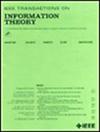Sparse Recovery Beyond Compressed Sensing: Separable Nonlinear Inverse Problems
IF 2.2
3区 计算机科学
Q3 COMPUTER SCIENCE, INFORMATION SYSTEMS
引用次数: 5
Abstract
Extracting information from nonlinear measurements is a fundamental challenge in data analysis. In this work, we consider separable inverse problems, where the data are modeled as a linear combination of functions that depend nonlinearly on certain parameters of interest. These parameters may represent neuronal activity in a human brain, frequencies of electromagnetic waves, fluorescent probes in a cell, or magnetic relaxation times of biological tissues. Separable nonlinear inverse problems can be reformulated as underdetermined sparse-recovery problems, and solved using convex programming. This approach has had empirical success in a variety of domains, from geophysics to medical imaging, but lacks a theoretical justification. In particular, compressed-sensing theory does not apply, because the measurement operators are deterministic and violate incoherence conditions such as the restricted-isometry property. Our main contribution is a theory for sparse recovery adapted to deterministic settings. We show that convex programming succeeds in recovering the parameters of interest, as long as their values are sufficiently distinct with respect to the correlation structure of the measurement operator. The theoretical results are illustrated through numerical experiments for two applications: heat-source localization and estimation of brain activity from electroencephalography data.压缩传感之外的稀疏恢复:可分离的非线性逆问题
从非线性测量中提取信息是数据分析中的一个基本挑战。在这项工作中,我们考虑了可分离的逆问题,其中数据被建模为非线性依赖于某些感兴趣参数的函数的线性组合。这些参数可以表示人脑中的神经元活动、电磁波的频率、细胞中的荧光探针或生物组织的磁弛豫时间。可分离的非线性逆问题可以重新表述为欠定稀疏恢复问题,并使用凸规划求解。这种方法在从地球物理学到医学成像的各个领域都取得了经验上的成功,但缺乏理论依据。特别地,压缩传感理论不适用,因为测量算子是确定性的,并且违反了非相干条件,例如受限等距性质。我们的主要贡献是适用于确定性设置的稀疏恢复理论。我们证明了凸规划能够成功地恢复感兴趣的参数,只要它们的值相对于测量算子的相关结构足够不同。通过两个应用的数值实验说明了理论结果:热源定位和根据脑电图数据估计大脑活动。
本文章由计算机程序翻译,如有差异,请以英文原文为准。
求助全文
约1分钟内获得全文
求助全文
来源期刊

IEEE Transactions on Information Theory
工程技术-工程:电子与电气
CiteScore
5.70
自引率
20.00%
发文量
514
审稿时长
12 months
期刊介绍:
The IEEE Transactions on Information Theory is a journal that publishes theoretical and experimental papers concerned with the transmission, processing, and utilization of information. The boundaries of acceptable subject matter are intentionally not sharply delimited. Rather, it is hoped that as the focus of research activity changes, a flexible policy will permit this Transactions to follow suit. Current appropriate topics are best reflected by recent Tables of Contents; they are summarized in the titles of editorial areas that appear on the inside front cover.
 求助内容:
求助内容: 应助结果提醒方式:
应助结果提醒方式:


